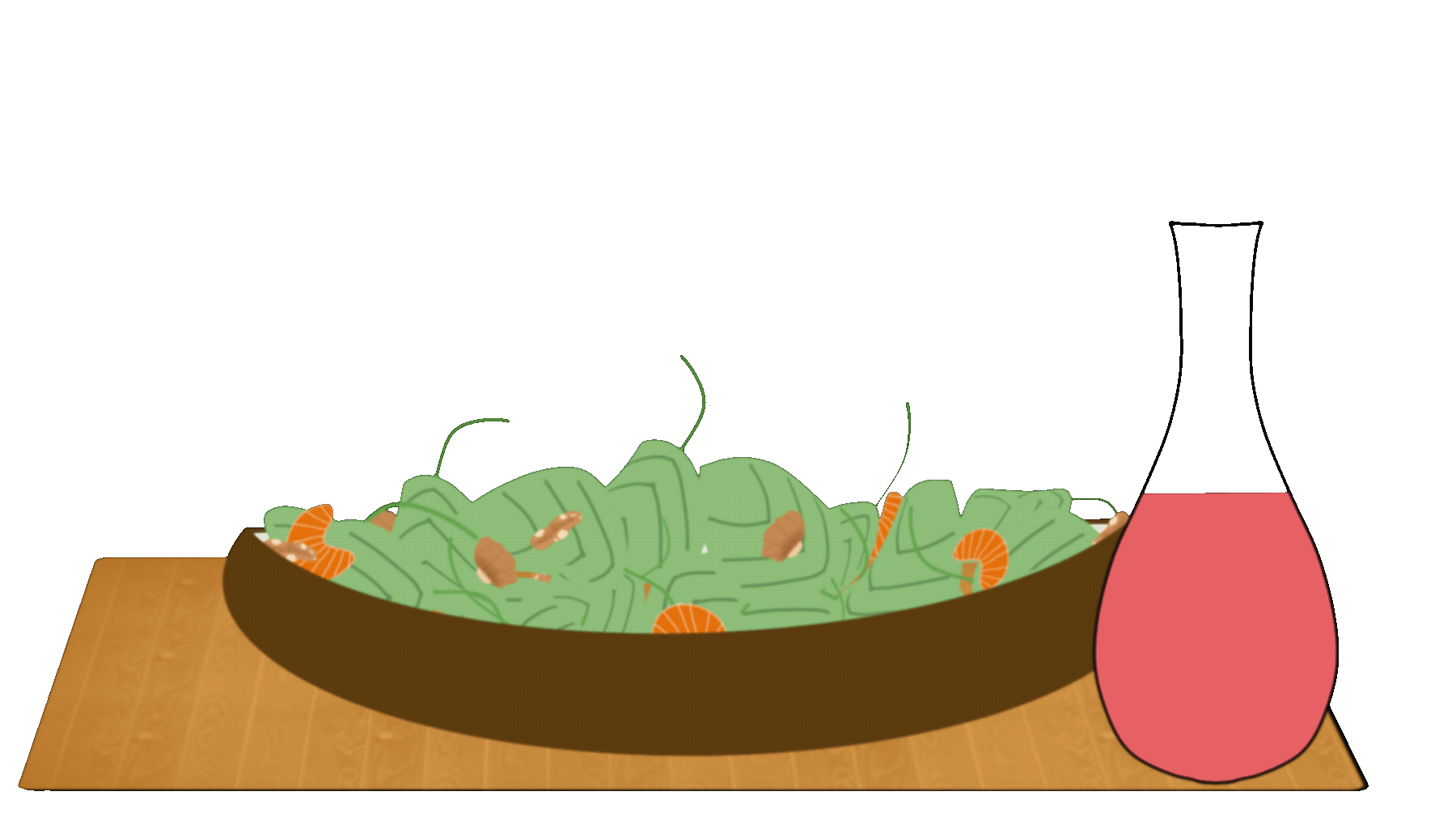(or two).
 Raspberry splash
Raspberry splashSalad for one
Easy, nutritious, versatile, and yummy, salad is the envy of lesser weekly whip ups. Here's how to meal prep fresh salad for one, so tossing and topping is fast and fun!
The question of how to plan and prep a week's worth of salad for one can be answered in myriad ways, as the possibilities are practically endless.
Crispy, creamy, crunchy, chewy, savory, sweet,...cold, warm, raw, roasted,...veggies, fruits, chicken, beef, pork, seafood, plant proteins,...nuts, seeds, cheese, croutons, crisps,...pasta, bean, lentil, potato, slaw, whole grain...
Salad is everything.
Whether planning salad first, then spreading surplus ingredients across other recipes or building a base/dressing for using up recipe scraps, salad prep can help busy singles make the most of fresh food.
Mix and match.
 Lettucea (Letty) Spinner, produce interventionist at Save the Celery, where cutting board scraps are "firmly encouraged" to participate in salad creation. Owner of Enviabowl Salad Dressings.
Lettucea (Letty) Spinner, produce interventionist at Save the Celery, where cutting board scraps are "firmly encouraged" to participate in salad creation. Owner of Enviabowl Salad Dressings.O.f.O. style weekly meal planning starts with coordinating recipe choices to use up not-so-freezable perishables like fresh produce, so nothing goes to waste. That's why the Plan & Shop page includes a Mix & Match Scratch Pad designed for creating clear purposing pathways across each week's menu.
Here's how to use the pad:
- To begin planning, slide the pad next to the Recipes column.
- While choosing recipes, refer to recipe ingredient lists to spot potential leftover perishables.
- Note each recipe's potential leftovers on the left column of the pad.
- Match leftovers with other recipes.
- Copy color coded recipe titles from the "Recipes" column onto the right column of the pad beside assigned leftovers.
Creatively mixing and matching salad ingredients leads to otherwise overlooked flavor combinations. Go for it!
- Plan salads with surplus/set aside ingredients from the week's recipes.
- Whip up fresh homemade mayo to mix into dressings.
- Cold-water-bath-thaw single serving freezer preps like cooked proteins.
- Incorporate tiny frozen foods like peas or corn after just a few minutes of defrosting at room temp.
- Cook and cool whole grains, beans, lentils, pasta, or potatoes from the pantry.
- Compliment veggies with fruit like apples, pears (both go with almost everything), citrus wedges or dried berries.
- Add extra crunch with crushed nuts, croutons, or other crispy things. In my experience, nuts, crackers, and chips keep well in the freezer, and don't actually seem to freeze, so no defrosting is necessary. Frozen homemade croutons may take 30 minutes or so to defrost at room temp. Crisp them in the oven for a few minutes, if needed.
Here are a few yummy salad ideas:
 Red grapes
Red grapes- Boil and blend a small batch of potato egg salad loaded with fresh produce, pickles, and olives.
- Toss a true Caesar with homemade croutons, anchovies and hand grated Parm.
- Pressure cook and cool wheatberries for a sumptuous salad with kale, fruit, and nuts.
- Whip up a creamy Waldorf with chopped apples, sliced grapes, crisp celery, and toasted walnuts.
- Reach for the sky - make an amazing chicken Thai!
- Mix and match recipe scraps with surplus greens, nuts/croutons, cheese, fruit and homemade dressing.
Light on lettuce?
 Salad is everything
Salad is everythingWhen homemade dressing and chopped veggies outlast the week's lettuce supply, it's perfectly okay to toss a "green" salad anyway, sans lettuce. Mixing and matching chopped veggies, recipe scraps and pantry/freezer staples can fill out a crunchy, chewy salad beautifully.
Lettuce is lovely, but salad can be anything, so make your own rules!
Cover all the bases.
Salad recipes can be adapted by swapping base ingredients like greens, grains, or pasta. For example, traditional antipasto salad adapts to green antipasto, whole grain antipasto, pasta antipasto, etc.
Dressing run dry?
 Dijon
DijonDon't fret. Delicious pantry dressing recipes are super simple to scale down and whip up with just a few basic ingredients.
Staples like oil, vinegar, sugar, honey, molasses, mustard, garlic, onion, dried herbs, Parm, mayo, greek yogurt, sour cream, and milk can mix into quick homemade dressings.
Celebrate one cute cucumber.
Dress up a single flavor element, like a cucumber, to star in it's own elegant salads, accessorized with tasty dressings like classic, creamy, Greek, Thai, or Italian. Fortify with a base like pasta or quinoa to make it a meal.
Baby spinach, you're a star!
Nutritious and flavorful, a well dressed spinach salad can hold it's own without many other ingredients. Much like kale, spinach serves as a star ingredient in many cooked foods, making it a marvel of a mix and match vehicle for cooked recipes and salads.
Greens that go hard.
While deciding how to meal prep salad for one, look to long lasting greens for inspiration. Dark greens like kale, arugula, and spinach can keep for about a week if purchased fresh. Leftovers may be frozen for adding into cooked recipes or smoothies later.
Whole head cabbage is the queen of keeping in the fridge! Whole head lettuce keeps nicely, but once chopped, it's lifespan shortens drastically.
Pondering pre-washed produce?
Boxed organic microgreens can be pretty fresh and wonderful to work with, but bagged iceberg and romaine typically aren't as crisp and tasty as the open air options. I wash all greens, whether pre-washed, or not.
Keep your head.
Crisp, mild iceberg makes a light, clean base for complimenting all kinds of ingredients. For longer lasting iceberg, forget prepping-ahead. Store the head intact, and only tear off leaves as needed for fresh servings.
Organic hydro whole-head butter lettuce keeps very well, and it's one of my favorite choices for a mild, versatile base. I often purchase two heads at once.
Soaking solutions.
The key to getting all kinds of produce good and clean is short-term soaking. Take advantage of soaking time to tackle tiny tasks, or just veg out while the water does it's work.
When it comes to killing cooties on fresh greens, there are several schools of thought:
- The C.D.C. recommends rinsing and soaking with plain tap water.
- The U.S.D.A. offers 1/2 cup distilled vinegar per cup of water as an option, but warns that texture and flavor may be compromised.
- Popular commercial produce cleansers, although not endorsed by "authority" sites, appear to be trusted by consumers, according to published reviews.
- Veggie Wash brand spray has been popular with consumers (myself included) for decades. I love the citrus smell and sudsy cleaning power of it, but I often just use a simple vinegar dilution, because it's cheaper.
- Biochemist Annie Pryor, P.H.D., of Dr. Annie's Experiments has demonstrated good results by rinsing spring mix for 30 seconds, soaking in 25% white vinegar with water for ten minutes, followed by another 30 second rinse. Thank you, Dr. Annie! Check out her site for insight into her first-hand findings on the efficacy of household cleaning products and methods.
Treat single serving lettuce prep as a finishing-touch micro-task.
Fresh salad for one is best done when lettuce prep is knocked-out last minute, but the simple process of washing and drying small amounts of lettuce flies by with the right routine and tools.
Rinsing and soaking a days worth of salad greens is easy, and requires no cleanup beyond dropping an already rinsed out salad spinner into the dishwasher.
Here's how I wash lettuce for salad:
- Rinse full leaves one at a time under a filtered faucet, then tear into bite sized pieces and drop into a salad spinner basket. Fill the spinner with cool (not ice cold) water and white vinegar.
- Soak for 10-20 minutes, maybe give the contents a gentle jostle once during soaking to loosen potential debris, then remove the basket and drain.
- Re-rinse & spin. I often skip the re-rinse to save water (especially while camping).
Here's what to buy for a good wash & dry:
- Water filtration for kitchen faucet.
- Produce scrub brush.
- Your favorite produce wash.
- Salad spinner. Such a handy cleaning tool, it practically cleans itself during use!
- Heavy duty paper towels or flour sack towels.
Here's how to keep prepped lettuce fresh in the fridge:
Salad spinners allow just enough ventilation and moisture to keep lettuce fresh and crisp for a day or so. To store washed salad greens for the day; simply spin, drain, close the lid, and pop into the fridge.
Routine lettuce prep is easy, especially once it becomes a habit. Try giving it a spin!
Here's what to buy for produce prep:
- Chef's knife and cutting board. I typically prep almost all of my salad ingredients with these two tools.
- Hand held citrus juicer.
- Microplane zester.
- Garlic press (or smash, slice and dice cloves with a chef's knife).
- Chopper/slicer system or food processor. I own both a manual chopper/slicer and an electric food processor/meat grinder with multi-blade attachment. Both work, but I much prefer the processor! I like it for "crushing" nuts, shredding frozen bread into breadcrumbs, and processing freshly sprouted wheat berries into dough for baking no-flour whole wheat bread with my breadmaker.
- My favorite prep tool: The Presto salad shooter. Trust me. Try a Presto salad shooter once, and never use a cheese grater again! It's also an okay slicer (not a chopper).
Store and serve salad with style.
- Small glass mason jars and prep bowls with locking lids are perfect for storing chopped veggies and other salad preps in the fridge.
- Mason jars can be fitted with handy spout lids for dressing.
- Salad spinners are ideal for refrigerating prepped lettuce for a day or so.
- The fridge's crisper drawer is the perfect place for safely separating whole head/un-prepped lettuce from other off-gassing produce items.
Salad is best served in a luxuriously oversized wide-bottom bowl or lipped plate.
Getting set up with the right tools and a yummy selection of salad preps helps weekly meal plans come together beautifully.